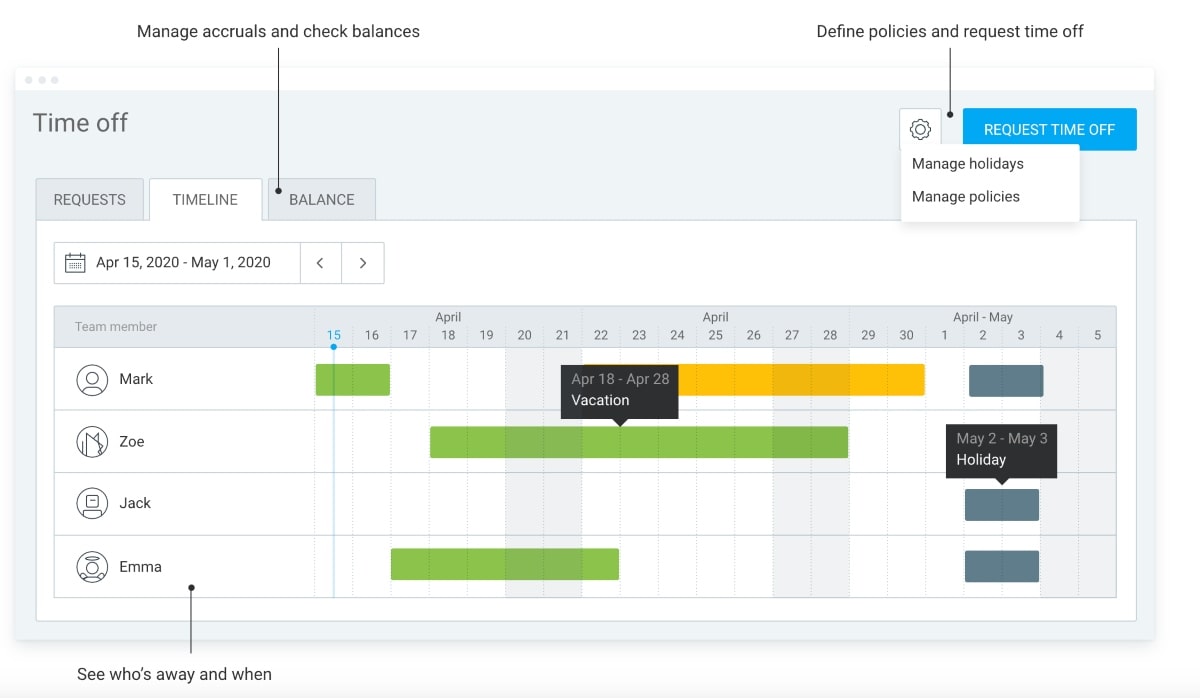Your ultimate PTO accrual guide: Definition, benefits, and tips
Most employers understand that offering competitive salaries and benefits is essential. However, they often overlook one aspect of employee compensation: paid time off (PTO). In fact, a recent SHRM survey showed that 82% of workers believe that leave benefits are “very important” in their place of work.
But here’s the catch: simply having a time off policy won’t be enough. A poorly designed PTO program can do more harm than good, leading to a loss of your company’s resources.
So, in this article, we’re going to dive deep into the world of PTO accrual policy, exploring:
- What PTO accrual is,
- What its benefits are,
- How to create a PTO accrual policy, and
- How to calculate accrued PTO manually.

Table of Contents
What is PTO accrual?
PTO accrual is a type of personal time off policy that allows employees to earn paid time off based on a specific timespan.
However, paid time off is not clearly defined by US law. In most cases, PTO policies combine three types of leave:
- Vacation days,
- Sick days, and
- Personal days.
We contacted Levon L. Galstyan, Certified Public Accountant at Oak View Law Group, for help with defining PTO accrual:

“PTO accrual is a method used by employers to track and manage the amount of paid time off that an employee has earned and taken over a specified period. PTO accrual policies vary between companies, but the basic principle is that employees earn a certain amount of PTO for each hour, day, or pay period worked.”
He further explains how employees can use PTO accrual:

“Accrued PTO can typically be used for any reason, including:
- Vacation time,
- Personal days,
- Sick leave, or
- Other approved absences from work.
The policy for taking PTO may differ between employers, but many companies require employees to request time off in advance and receive approval from their manager.”
Although the US law doesn’t require employers to have PTO policies in place, some states have their own personal time off regulations. But, none of the state laws mandates employers must enforce PTO accrual, as the type of time off policy is completely up to them.
PTO accrual vs. allotment (lump sum) PTO
The two most popular leave policies are:
- PTO accrual, and
- Lump sum (allotment) PTO.
Allotment (lump sum PTO) is a paid time off policy in which workers have a set amount of paid time off during a year. Founder and CPA at The Alajian Group, Armine Alajian, clarifies:

“Lump sum PTO is a fixed amount of paid time off that your employer gives you at the beginning of the year, regardless of how many hours you work.”
This time off can either expire or roll over in the next year. Moreover, some companies pay workers for unused allotted time off during the year.
Armine Alajian explains that the difference between these two terms is in the way they are calculated:

“The main difference between PTO accrual and lump sum PTO is how your employer calculates the amount of paid time off you receive. With PTO accrual, your PTO is based on the number of hours you work, while with lump sum PTO, everyone gets the same fixed amount of PTO, regardless of how many hours they work.”
Levon L. Galstyan’s insights helped us create a table with the main differences between accrual and allotment PTO policies:
| Differences | PTO accrual | PTO allotment |
|---|---|---|
| Payment Timing | Employees earn PTO over time. | Employees receive all of their PTO at once. |
| Cash Value | A cash value equal to the employee’s hourly rate or salary multiplied by the number of hours accrued. | A cash value equal to the employee’s hourly rate or salary multiplied by the number of hours of unused PTO. |
| Employer Liability | Employers must track employees’ accrued PTO and ensure that they are providing employees with the time off they are entitled to, which can create logistical challenges. | Employers must have the financial resources to cover employees’ PTO usage in a lump sum when an employee requests it, which can create financial challenges. |
→ Note: The data in this table isn’t official. The FLSA doesn’t contain any obligations to employers regarding PTO and the type of PTO policy they create for their employees.
Benefits of accrual time off
Accrual time off comes with a lot of perks for both employees and employers. So, it’s time to go more into detail on what your company can gain by switching to accrual time off.
Benefit #1: PTO accrual encourages employee retention
PTO accrual allows you to organize a paid leave policy at your company however you want. If you want to encourage employee retention, you should create a policy that:
- Is based on the years of service, or
- Allows for a transfer of unused time off throughout the years.
You should consider adding higher PTO rates for people who’ve been part of your team for a longer time. That way, your workers are more motivated to stay within the company and collect more days off as time goes by.
Benefit #2: PTO accrual prevents new employees from taking too much time off
With accrual, your employees won’t receive their PTO all at once. Thus, they won’t have too many days off at their disposal when they first start working for your company.
This kind of policy prevents new employees from taking too much time off in the beginning since their PTO will accumulate as they continue working.
Benefit #3: PTO accrual provides a reward for loyal workers
PTO accrual is collected over time. So, your most loyal workers should have the most paid time off during the year.
If you choose to have a policy that allows for a higher accrual rate after certain milestones for years of service, employees who’ve been working at your company the longest reap the most benefits.
How to set your PTO accrual policy
Before you set your PTO accrual policy, you should first make sure you understand all of the steps that go into it.
Step #1: Check your state and local laws
The law does not include any paid time off regulations on the federal level.
In most cases, employers have the freedom to create a PTO policy that works for them. Still, some local laws provide minimum eligibility requirements or give employers the option to limit the time off workers can accrue.
So, your first step in creating an accrual policy for your company is to check your state and local laws.
Step #2: Consider the potential accrual cap
Many employers use accrual PTO policies to reward loyal workers. Thus, higher accrual rates for employees who work in a company longer are common.
Having this kind of reward is great for employee retention. However, you should take your resources into account. If your policy is too generous, you may end up losing a lot of money on paying out the leaves. So, it’s wise to set a maximum number of days off an employee can accumulate.
In the US, employees usually have 10 to 15 vacation days available. The actual number depends on the years of service and whether the employee works in the private or public sector.
Step #3: Choose the accrual period and the accrual rate
Your accrual policy includes the accrual period and the accrual rate.
The accrual period is how often your employees can accumulate their days off. The most common accrual periods are:
- Hourly,
- Weekly,
- Biweekly,
- Monthly,
- Yearly, and
- Per pay period.
Levon Galstyan defines accrual rate as:

“The rate at which an employee earns or accrues paid time off over time. The accrual rate is typically based on a certain number of hours worked, and can vary depending on the employer’s policy.”
He also provided us with an example:

“An employer may have an accrual rate of 0.057 hours of vacation time earned per hour worked. This means that for every hour an employee works, they would earn 0.057 hours of vacation time. If the employee works 40 hours per week, they would earn 2.28 hours of vacation time per week (0.057 x 40), or 119 hours of vacation time over the course of a year (0.057 x 2,080, assuming a 52-week year).”
It’s up to you, as an employer, to decide what a good accrual rate is. Levon Galstyan highlights this ability:

“Accrual rates can vary based on the employee’s length of service or job title. For example, an employer may offer a higher accrual rate to employees who have been with the company for a certain number of years, or to employees in higher-level positions.”
🎓 Clockify Pro Tip
If you suspect that creating a thorough PTO policy will take too much time, you can always use a template to speed up the process. Find one here:
Step #4: Regulate the PTO rollover or payout policies
You should consider two important aspects in your accrual policy:
- PTO rollover, and
- PTO payout.
PTO rollover
Founder of the accounting firm AgileCPA Professional Corporation, Wendy Ha, defined the PTO rollover as “the unused time that the employee can take the next period.”
Moreover, an accountant at Keirstone Limited, Francis Fabrizi, explained the ins and outs of rollover:

“PTO rollover can be subject to certain limitations such as a maximum number of hours that can be carried over, or a ‘use it or lose it’ policy where any unused PTO is forfeited at the end of the year. PTO rollover policies can vary widely between employers, so it’s essential to understand the specific policy in place at the company.”
While rollover is an amazing benefit to offer employees, Levon Galstyan warns about its potential liabilities:

“If too much PTO is carried over from year to year, it can create a large liability on the company’s balance sheet, as the company will eventually need to pay out the accrued PTO. Employers need to balance the benefits of a PTO rollover policy with the potential liabilities and ensure that their policies are sustainable over the long term.”
PTO payout
Wendy Ha explains PTO payout:

“PTO payout is the unused time that the company is required to pay out. Most companies choose to ‘rollover’ the unused paid time off to the next period and only pay out upon termination/resignation.”
Depending on the state or local laws, employers may be required to pay out unused PTO when an employee leaves the company, so keep that in mind as well.
An essential benefit to PTO payout is that it provides an additional source of income when leaving a job. But it also comes with downsides, as Levon Galstyan highlights:

“PTO payout policies can create potential liabilities for employers, as they will need to pay out any accrued PTO when an employee leaves the company. Employers need to ensure that their policies are sustainable over the long term and that they have a clear and consistent policy for PTO payout to avoid confusion or legal issues.”
PTO rollover and payout in an example
If you’re confused by these two terms, you’ll appreciate Wendy Ha’s example of rollover and payout:

“Colin works for a SaaS company and when he was hired on Jan 1, 2022, he was eligible for 3 weeks (15 days) PTO. On a monthly basis, he will be “accruing” about 1.25 PTO days: 15 days / 12 months. If he doesn’t use them, it will be rolled over to the following month.”
Wendy continues with the example:

“Assume he didn’t use any PTO in Jan and Feb 2022, he would have accrued 2.5 PTO days: 1.25 per month x 2. In March, he wants to go on a quick trip and he requested to take Thursday, Friday, and Monday off. At the end of March, he would have 0.75 days left to roll over into April 2022: Jan 1.25 + Feb 1.25 + Mar 1.25 = 3 days taken off.”
She completes the example with a final calculation:

“Finally, let’s assume he won the lottery and no longer needs to work. He resigned on April 30, and he now has 2 PTO days: Apr 1.25 + 0.75 (leftover from Jan to Mar). Thus, the company would need to pay this out to him in cash.”
Step #5: Communicate the accruing time off policy to your employees
You need to set clear policies around PTO accrual, usage, and payout, and communicate these policies to your employees. That way, you’ll avoid confusion and make sure every worker is aware of the accrual policy and how they’re collecting their days off.
How to calculate PTO accrual
Managing accrued time off for every employee can be challenging. Luckily, the process of manually calculating time accrued is much easier with our guide!
Calculating time accrued manually
Your first option is to calculate your employees’ PTO manually. You have little to no room for error, so follow our steps carefully.
Step #1: Take the PTO accrual rate and period you decided on
As we mentioned, the accrual rate is an essential component of your policy. Let’s say that your employee accrual rate is 0.5 days of PTO for every month of service.
Many employers prefer keeping records of employees PTO in the number of hours. To do that, you’ll need to convert PTO days per month to the number of PTO hours.
In our example, we’ll assume that an employee works 8 hours a day. You need to multiply the total number of hours an employee works in a day by the accrual rate per day. So, the calculation is:
The total number of working hours per day x accrual rate per day = accrual rate per hour
Since this employee earns 0.5 days of PTO every month, that’s:
8 x 0.5 = 4
Thus, your workers’ PTO rate per month is 4 hours.
🎓 Clockify Pro Tip
Do you find tracking your employees’ time off difficult? You’ll certainly benefit from these tips:
Step #2: Choose a timespan
Your next step is choosing a timespan for which you’ll be calculating the accrued time off. Suppose the interval for which you want to calculate PTO is 1 year or 12 months.
Step #3: Calculate the PTO earned
The calculation for earned PTO is:
Accrual rate x timespan = time earned
In our example, the rate is 0.5 days per month and our timespan is 12 months. So, the calculation will be:
0.5 x 12 = 6 days off
Let’s see how the calculation will look like if we take the number of PTO hours instead. In this case, the accrual rate is 4 hours per month. So:
4 x 12 = 48 hours off
Step #4: Add the PTO earned to the employee’s balance
In case your company has a rollover policy in place, any unused PTO presents an employee’s initial balance. To complete the process, you should add the newly earned PTO to the worker’s previous balance.
If you set the maximum amount of PTO time your employees can earn (accrual cap), you should keep this number in mind when calculating PTO. Once a worker reaches the cap, they can’t accrue any more time off.
Let’s say that an employee had a PTO balance of 3 days of unused time off before and they have earned 6 days of PTO in the past 12 months, their new balance would be:
3 days + 6 days = 9 days of PTO
The calculation is similar for PTO in hours. Your employee has 24 hours of unused time off and has earned 48 hours in the past year. Their new balance is:
24 + 48 = 72 hours of PTO
If the final PTO amount is a decimal number, you can round your employee’s hours to the nearest whole number.
PTO accrual FAQ
Do you still have some questions about PTO accrual? We’ve got you!
Here’s what most employers wonder about when it comes to PTO accrual policies.
1. What is the average PTO accrual rate?
On average, employees in the private sector have 10 PTO days after one year of service. From this stat, we can calculate the standard PTO accrual rate for new workers:
10 (PTO days) / 12 (months in a year) = 0.8 days off per month
In addition, the average PTO for those who’ve been working in the private sector for more than 5 years is 15 days. So, the average accrual rate for long-term employees is 1.25 days per month.
You can use these stats to come up with a fair accrual rate for your business.
2. How many days is 40 hours of PTO?
If an employee works 8 hours a day, 40 hours of PTO is equal to 5 working days.
You’ll calculate the number of days off an employee can take by dividing the number of hours of PTO they have by the number of hours they work in a week. In this case, the calculation is:
40 (PTO hours) / 8 (working hours a day) = 5 (days off)
3. How do you calculate PTO by hours worked?
You’ll get to the amount of PTO a worker accumulated over time by multiplying the number of hours they worked by the accrual rate per hour.
Let’s assume your employees can accrue one hour of PTO for every 40 hours they work. You want to calculate the amount of PTO for an employee who worked 80 hours.
You should first determine the accrual rate for your company. The accrual rate is the number of PTO hours an employee can receive divided by the number of hours of work they have to input. So:
1 (hour of PTO) / 40 (hours) = 0.025 (accrual rate)
Then, you should multiply the accrual rate by the number of hours worked:
0.025 x 80 = 2
Your worker has earned 2 hours of PTO during 80 hours of work.
4. How do you calculate PTO by days worked?
In case your workers accrue their PTO by days worked, you’ll have to multiply the accrual rate by the period they worked to get their final PTO amount.
If the accrual rate is 0.8 days per month, the calculation for an employee that worked 6 months will be:
0.8 x 6 = 4.8 days off
You can round this amount to the nearest whole number: 5 — giving your employee 5 days off.
5. How do I make the process of tracking PTO accrual easier?
Tracking accrued PTO for all of your employees can be challenging. Thus, you should consider using software to track workers’ PTO.
Clockify is a time tracker that offers many extra features you’ll benefit from. With PTO & Vacation Tracker, you can set a time off policy for your company and track employees’ accruals and leaves. In addition, your workers can request personal time off and log attendance via Clockify.

Conclusion: Opting for PTO accrual allows for a fair PTO distribution
By offering accrual PTO, employers can attract quality workers, improve employee retention, and prevent new employees from taking too many days off at the beginning.
However, a successful PTO accrual policy requires careful planning and clear communication with employees. Aside from your company’s needs, you should also take into account legal requirements in your city and state. So, once you make sure you’ve double-checked the legalities, you can start creating an accrual PTO policy for your company!
We strongly advise you to consult the appropriate institutions and/or certified representatives before acting on any legal matters. Clockify is not responsible for any losses or risks incurred, should this guide be used without legal guidance.

